We return to earth after our brief visit to the moon in the past couple of articles and examine sites that are aligned to the moon.
Most people are familiar with the seasonal path of the sun – that it rises in the east and sets in the west, more or less. The motion of the moon, however, is more complex and perhaps, as a result, is seen as being more mysterious. (Professor Judith Young provides a nice explanation in her article Moon Teachings for the Masses.)
In this article, with the help of a newly developed archaeoastronomy app, we review sites from around the world that are aligned to the moon.
Britain
We start in Britain the home of Stonehenge, one of the most famous and enigmatic of all ancient sites. Although it is generally known when it was built, around 3100 BCE, no one knows exactly why it was built or by whom.
Around 2600 BCE a large stone known as the Heel Stone was added outside of the inner circle of stones and positioned so as to line up with the summer solstice sunrise when it is viewed from the center of the site. At the same time, four other outlying stones called Station Stones were arranged to form a rectangle around the central monument. One of the Station Stones was positioned in the direction of maximum southern moonrise, also called a major lunar standstill. Today, these alignments are off by about a degree due to the change in earth’s obliquity since the time they were set into place more than 4000 years ago.
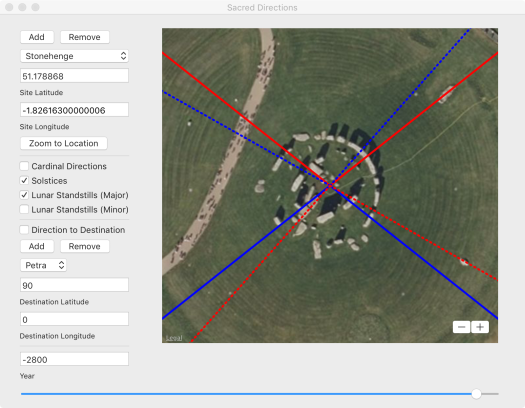
There are other sites in Britain that also appear to reference the motion of the moon. The Calanais Stones are in the Outer Hebrides in Scotland. The circle of stones, which is thought to have been set in place between 2600 and 2800 BCE has been interpreted by several researchers to have been used as a lunar observatory.

Middle East
A little later in Mesopotamia King Ur-Nammu built a ziggurat dedicated to Nanna, the son of the two original Sumerian deities, Enlil and Ninlil. Nanna was the god of the moon and wisdom yet ironically the temple dedicated to him was called “Etemennigur,” which means “House whose foundation creates terror.” As shown in Figure 3 the Ziggurat of Ur is aligned in the direction of maximum northern major lunar moonrise and maximum southern major lunar moonset with best alignment achieved around the accepted time of construction, approximately 2100 BCE.

India
Few temples in India appear to be aligned to the moon. According to Sikh historical records, the land that became Amritsar was chosen by Guru Amar Das, the third Guru of the Sikh tradition. Arjan, the fifth Sikh guru, completed the Golden Temple in Amritsar in 1604. The overall layout of the site including the reflecting pools is consistent with the direction of minor lunar standstills. (Recall major standstills are the most northern and southern moonrises and moonsets and so minor standstills are the least northern and southern moonrises and moonsets.) What is unusual about the site is that the best alignment is achieved when the earth was at minimum obliquity, approximately 14,000 years ago (Figure 4). If the Golden Temple is aligned to the moon perhaps Amritsar had been an even earlier site of religious significance.

Southeast Asia
Continuing east, the Khmer empire constructed monumental cities and religious sites in Cambodia around a thousand years ago. Where most places including Angkor Wat and Angkor Thom are aligned to the cardinal direction, others such as Preah Khan and Koh Ker are not.
Preah Khan of Kompong Svay is approximately 100 km east of Angkor Wat. It consists of a series of four concentric rectangular enclosures that contain temples, buildings, and a central sanctuary. According to Giulio Magli the site is aligned to the moon, specifically to the northern major lunar standstill. Based on a single dated inscription, the site is thought to have been built around 1000 CE, which turns out to be consistent with the alignments in Figure 5.
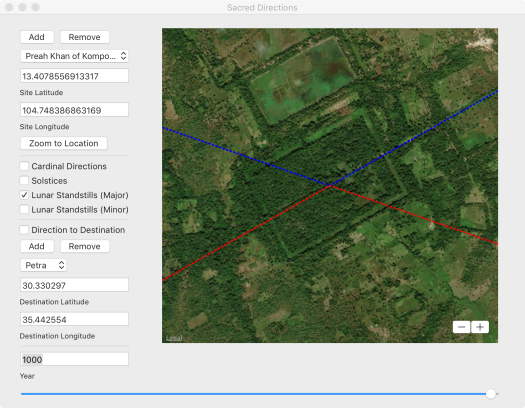
Koh Ker is 50 km north, northwest of Preah Khan. In the same paper referenced above, Magli argues that Koh Ker is aligned in the direction of sunrise on the day when the sun rises directly over the site (zenith passage). Figure 6 suggests another possibility – that the site was aligned to the northern minor lunar standstill approximately 15,000 years when the earth was near minimum obliquity.

Central America
As discussed in Before Atlantis, Chichen Itza and Tulum are two sites in Mexico’s Yucatan Peninsula that might have been aligned to an earlier location of the North Pole in the Norway Sea. Many of the structures at Chichen Itza including the Caracol also appear aligned with major lunar standstills (Figure 7). The Caracol is believed to have been used as an observatory by the Maya who were familiar with the motions of the sun, moon, stars, and planets. The alignment of most structures at Tulum also appears to be aligned with major lunar standstills (Figure 8).

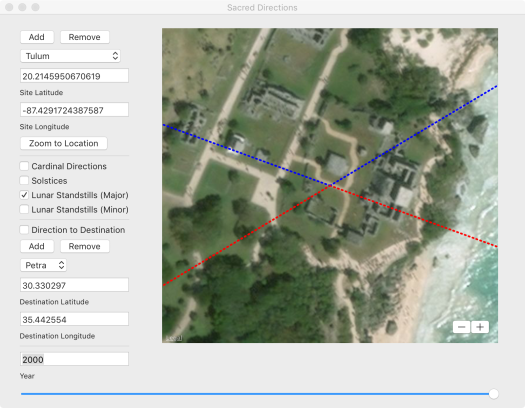
South America
Located in Peru, Chan Chan is believed to have been built around 850 CE by the Chimu culture. The etymology of the name is thought to be derived from the Quingnam “Jiang” or “Chang” which means Sun. The name could also be derived from the term: “Shian” where “Shi” translates as Moon and “An” as house, meaning House of the Moon.
As discussed in Before Atlantis, the orientation of Chan Chan correlates both the direction of the Norway pole and to major lunar standstills. One explanation that satisfies both the solar and lunar interpretations of its name is that the original site was constructed long ago when the North Pole was in the Norway Sea and so was originally aligned to the cardinal directions and to the sun. Later it was co-opted by the Chimu, who repurposed Chan Chan as a lunar site as a result of its serendipitous realignment to the moon.
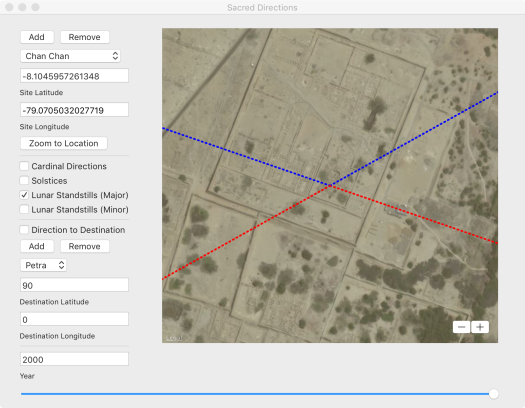
On a mountain top north of Machu Picchu lies a site called the Temple of the Moon that is built into an open-face, shallow cave. Like other places in Machu Picchu, the site is generally thought to have been arbitrarily named. Figure 10 shows the site in a Google Earth perspective view looking south.
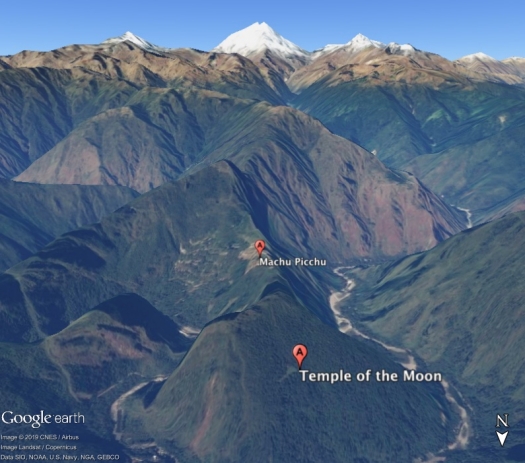
Being in the tropics south of the equator the sun moves north after sunrise at certain times of the year and south at other times. The moon also travels north after moonrise at certain times of the year as well. The cave opening faces north and spans the maximum possible northern range of lunar motion (Figure 11). That the cave was oriented in this direction for the purpose of observing the moon would seem to be no accident.
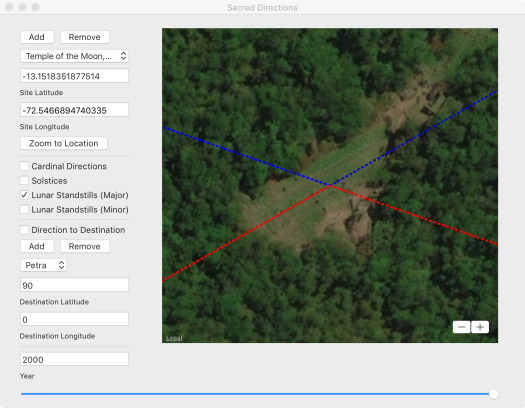
North America
We complete our journey around the world in North America and examine two Native American sites that appear to be aligned to the moon.
Ocmulgee Mounds National Historical Park in Georgia contains the remains of major earthworks built before 1000 CE by the South Appalachian Mississippian culture that includes the Great Temple Mound and other ceremonial mounds, a burial mound, and defensive trenches. Evidence suggests the site has been continuously occupied for 17,000 years. As shown in Figure 12 The Great Temple Mound appears to be aligned to the southern minor lunar standstill. The nearby Lesser Temple Mound also appears to be similarly aligned. Lunar alignments are thought to exist at Cahokia another Mississippian site in Illinois as well.
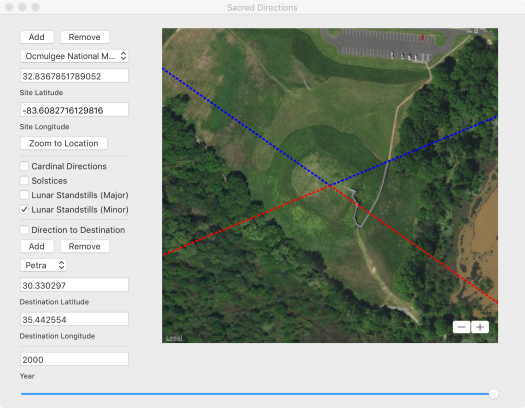
Pueblo del Arroyo is an archaeological site in Chaco Canyon, New Mexico. The structure was a “great house” built in the latter part of the 11th Century by the Ancestral Puebloan or Anasazi people, who are thought to have built many structures in alignment with lunar and solar (seasonal) cycles. Given the flatness of the surrounding terrain, the location of the site would seem to take full advantage of its alignment to the southern maximum moonrise and northern maximum moonset (Figure 13).
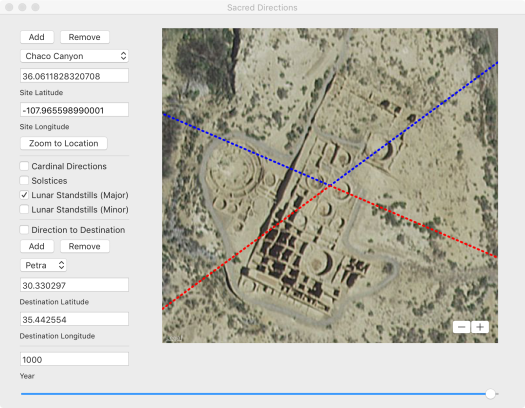
Summary
Numerous sites all over the world are aligned to the moon. Where the seasonal path of the sun is easily discernible, the complex motion of the moon, which repeats in 18.6-year cycles would have required dedicated observation over a much longer period of time. Although it is possible that the builders of these and other sites that are aligned to the moon did independently discern the complexity of lunar cycles it is also possible that this knowledge was inherited from an earlier people, perhaps from an unknown and highly advanced civilization that existed long ago.




Reblogged this on Die Goldene Landschaft.
LikeLike
Howdy! This post couldn’t be written any better! Reading this post reminds me of my old room mate! He always kept talking about this. I will forward this page to him. Fairly certain he will have a good read. Many thanks for sharing!
LikeLike